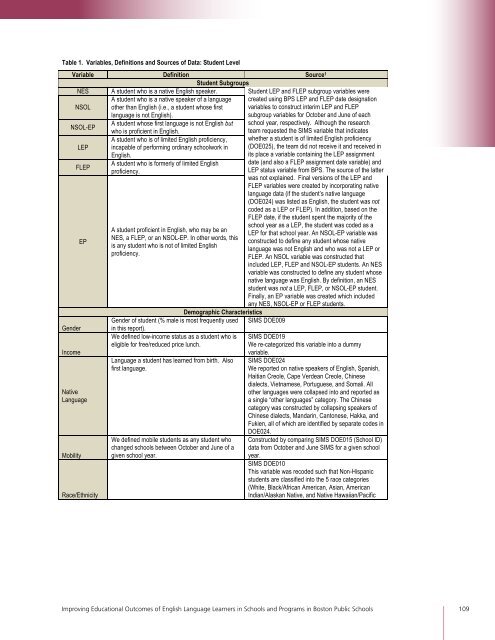Full Report - Center for Collaborative Education
Full Report - Center for Collaborative Education
Full Report - Center for Collaborative Education
Create successful ePaper yourself
Turn your PDF publications into a flip-book with our unique Google optimized e-Paper software.
Table 1. Variables, Definitions and Sources of Data: Student Level<br />
Variable Definition Source1 Student Subgroups<br />
NES A student who is a native English speaker.<br />
Student LEP and FLEP subgroup variables were<br />
A student who is a native speaker of a language created using BPS LEP and FLEP date designation<br />
NSOL other than English (i.e., a student whose first variables to construct interim LEP and FLEP<br />
language is not English).<br />
subgroup variables <strong>for</strong> October and June of each<br />
NSOL-EP<br />
A student whose first language is not English but<br />
who is proficient in English.<br />
school year, respectively. Although the research<br />
team requested the SIMS variable that indicates<br />
A student who is of limited English proficiency, whether a student is of limited English proficiency<br />
LEP incapable of per<strong>for</strong>ming ordinary schoolwork in (DOE025), the team did not receive it and received in<br />
English.<br />
its place a variable containing the LEP assignment<br />
FLEP<br />
A student who is <strong>for</strong>merly of limited English<br />
proficiency.<br />
date (and also a FLEP assignment date variable) and<br />
LEP status variable from BPS. The source of the latter<br />
was not explained. Final versions of the LEP and<br />
FLEP variables were created by incorporating native<br />
language data (if the student’s native language<br />
(DOE024) was listed as English, the student was not<br />
coded as a LEP or FLEP). In addition, based on the<br />
FLEP date, if the student spent the majority of the<br />
EP<br />
A student proficient in English, who may be an<br />
NES, a FLEP, or an NSOL-EP. In other words, this<br />
is any student who is not of limited English<br />
proficiency.<br />
school year as a LEP, the student was coded as a<br />
LEP <strong>for</strong> that school year. An NSOL-EP variable was<br />
constructed to define any student whose native<br />
language was not English and who was not a LEP or<br />
FLEP. An NSOL variable was constructed that<br />
included LEP, FLEP and NSOL-EP students. An NES<br />
variable was constructed to define any student whose<br />
native language was English. By definition, an NES<br />
student was not a LEP, FLEP, or NSOL-EP student.<br />
Finally, an EP variable was created which included<br />
any NES, NSOL-EP or FLEP students.<br />
Demographic Characteristics<br />
Gender of student (% male is most frequently used SIMS DOE009<br />
Gender in this report).<br />
We defined low-income status as a student who is SIMS DOE019<br />
eligible <strong>for</strong> free/reduced price lunch.<br />
We re-categorized this variable into a dummy<br />
Income<br />
variable.<br />
Language a student has learned from birth. Also SIMS DOE024<br />
first language.<br />
We reported on native speakers of English, Spanish,<br />
Haitian Creole, Cape Verdean Creole, Chinese<br />
dialects, Vietnamese, Portuguese, and Somali. All<br />
Native<br />
other languages were collapsed into and reported as<br />
Language<br />
a single “other languages” category. The Chinese<br />
category was constructed by collapsing speakers of<br />
Chinese dialects, Mandarin, Cantonese, Hakka, and<br />
Fukien, all of which are identified by separate codes in<br />
DOE024.<br />
We defined mobile students as any student who Constructed by comparing SIMS DOE015 (School ID)<br />
changed schools between October and June of a data from October and June SIMS <strong>for</strong> a given school<br />
Mobility given school year.<br />
year.<br />
SIMS DOE010<br />
This variable was recoded such that Non-Hispanic<br />
students are classified into the 5 race categories<br />
(White, Black/African American, Asian, American<br />
Race/Ethnicity<br />
Indian/Alaskan Native, and Native Hawaiian/Pacific<br />
Improving <strong>Education</strong>al Outcomes of English Language Learners in Schools and Programs in Boston Public Schools 109


